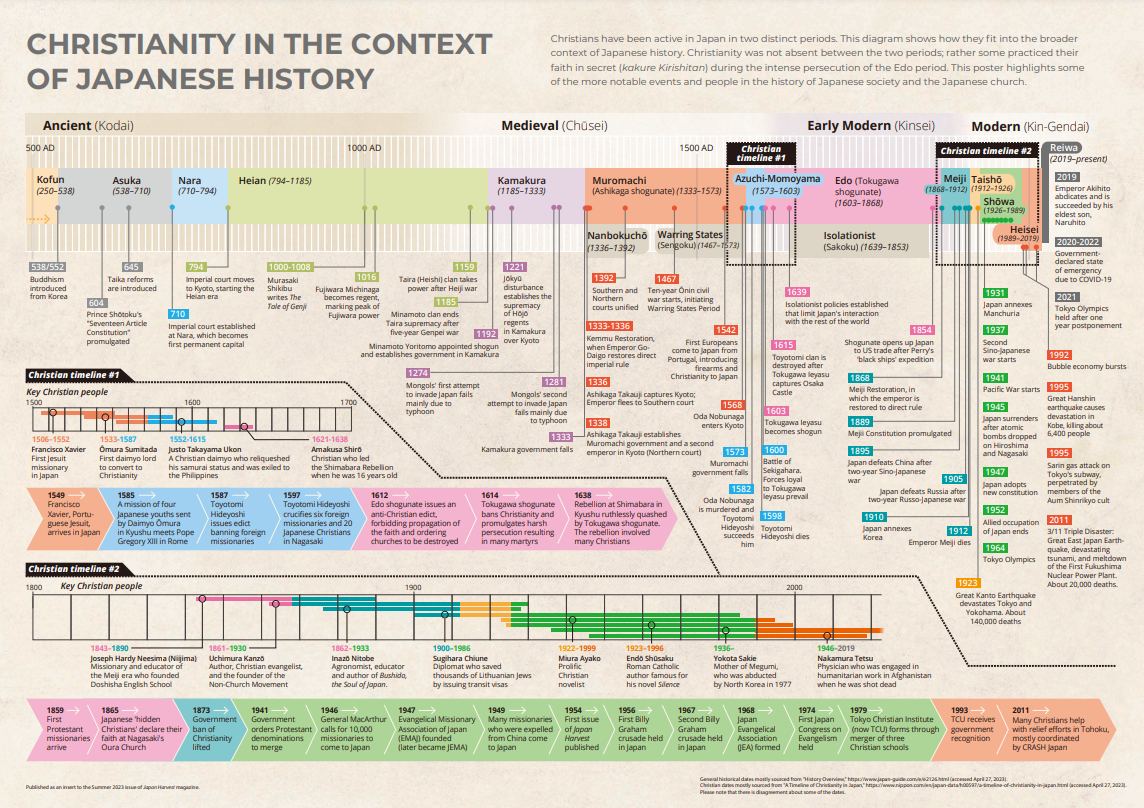Timetable of Christian History
This brief synopsis details the efforts of "Christianity" in Japan.
(Excerpts from Kodansha Encyclopedia of Japan)
1549 Francis Xavier establishes Japan's first Christian mission at Kagoshima
1587 Toyotomi Hideyoshi issues an edict expelling all Christian missionaries; it is not obeyed or enforced.
1597 Twenty Six Japanese and foreign Christians crucified at Nagasaki by order on Toyotomi Hideyoshi
1612 Shogunate issues directives aimed at restricting Christianity
1614 Ban on Christianity extended nationwide.
1622 51 Christians executed in Nagasaki
1624 Persecution intesifies.50 Christians are burned alive in Edo; Spanish ships prohibited from calling at Japanese ports
1635 All foreign ships restricted to the port of Nagasaki; overseas travel by Japanese restricted; Japanese residents abroad prohibited from returning to Japan
1837 Oldest existing Japanese version of any portion of the Bible is published in Singapore
1854 Fleet of Nine vessels, led by Commodore Matthew Perry anchors in Edo Bay
1860 The first American Baptist missionary, Jonathan Goble, arrives in Japan
1873 Meiji government withdrew religious sanctions, although freedom of religion was not specifically granted.
1888 Protestant translation of Old Testament complete
1917 Revised version of Protestant translation of New Testament complete
1941 Government pressure led to the formation of the Nihon Kirisuto Kyodan, or United Church of Christ in Japan, a union of some 30 Protestant churches.
Dr. and Mrs. Roy Byram and another missionary arrested in Oct. Charged with propagating a religion opposed to State Shintoism.
1942 42 Pentecostal Pastors arrested and charged for teaching the sovereignty of Christ upon his return.
1990 Christians numbered some 1,075,000 or less than 1 percent of the population. There were 436,000 Catholics with some 800 parishes in 16 dioceses, while Protestants numbered 639,000 with nearly 7,000 churches.
The immediate post World War II period witnessed a revival of Christian activity. The social upheaval and disillusionment caused by the nation's defeat prompted many Japanese to turn to Christianity to find some meaning in their lives. However, this period coinciding with the Allied occupation of 1945-52, was brief and the disorganization of the churches at the time prevented their taking full advantage of the opportunity.
In popular estimation Christianity is still regarded as a " foreign" creed, preaching admirable ideal but unsuitable for ordinary Japanese. Because of its "foreign" nature, the religion has been persecuted when demands for national unity were strong; it has been widely accepted during period of social instability (the 16th century, Meiji era, Post World war II) but once the social equilibrium was restored interest rapidly waned. Apart from the Nagasaki region Christianity has yet to make any appreciable impact on rural communities; it draws its strength from the urban, professional classes.
Various aspects of Christian teaching differ fundamentally from the more traditional pattern of Japanese thought and outlook--for example, monotheism vs. traditional polytheism; the concept of a transcendent God versus the immanent Japanese deities; an individual ethic versus a group-orientated ethic. It is doubtful whether organized Christianity can accommodate itself to the traditional thought in Japan as much as Buddhism (also an "imported" religion) has done but there still remains much scope for expressing Christian thought in a more Japanese form.
